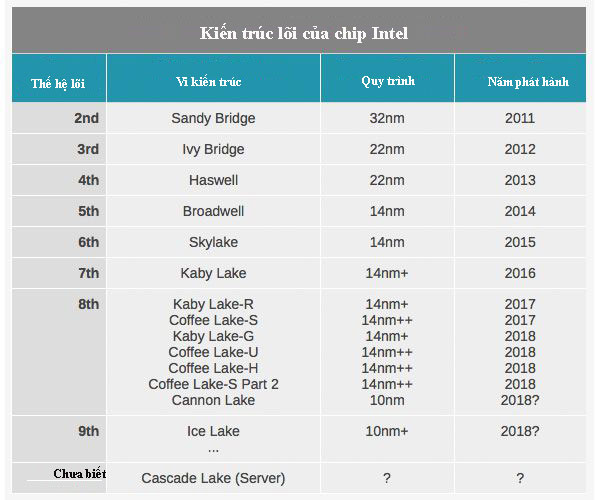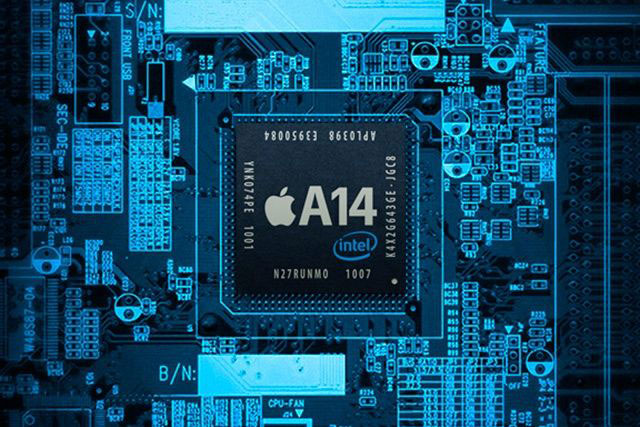Apple surpassed Intel because Intel just sat there
News that Bloomberg recently put has made speculation among observers in the technology world clearer: Apple is planning to replace Intel processors on Macs with its own chips. from about 2020.
These two California companies have had a long-standing cooperative relationship since Apple turned to Intel CPUs on the MacBook Pro and iMac in 2006. But recent trends show 'break up'. 'is inevitable.
- Apple will stop using Intel chips on Macs from 2020, switching to 'homegrown' chips.
Intel stomped on the spot while Apple continued to move up. The iPhone's SoC system now goes beyond Intel's Core laptop-class silicon. Even if Intel does not abandon its own king, the future Apple is building will be brighter if they use their own chips.
Apple's decision to abandon the world's most popular laptop and desktop CPU can be fundamental, but there are many important factors that make this choice unavoidable.
Intel's stagnation
At any technology fair / exhibition, you'll also see Intel claiming / re-declaring processor improvements. Whether it is IFA in Berlin, CES in Las Vegas or Computex in Taipei. The future will be wireless, the battery is very important, and many people using a 5-year-old PC will see the difference when buying a new Intel computer.
All are very optimistic with the pace of Apple. When Apple gave you, at most 2 years with the iPhone, upgraded to a new device, Intel tried to persuade computer users half a century ago to do the same.
Previously, Intel's pace of change was about one-year micro architecture and one-year production process. But Moore's law was declared dead since 2015. Intel has reached the limit of what can be done and doesn't know what to do next. The table below provided by AnandTech shows their situation.
Nvidia: Moore's Law is dead, the GPU will soon replace the CPU
See how long the 14nm process has suffered, the question mark behind 10nm and the absence of a future roadmap. In previous years, Intel's ambitious plan was known. (Saying that they are more secretive, they don't seem to have anything to keep it a secret). And without Intel's ability to save power from smaller chips, Intel cannot compete with ARM chips.
 Apple surpassed Intel because Intel just sat there Picture 1
Apple surpassed Intel because Intel just sat there Picture 1
Intel microarchitecture change process
Apple ambition
If using a word to define what Apple is doing, it is 'consolidated'. From integrating the board components to integrating the entire ecosystem of Apple devices like iPhone, Mac, AirPod and HomePod, integrating supply chain and centralized distribution.
Apple is starting to redesign the iPhone chip because it doesn't want to depend on Qualcomm. A year ago, they started making their own graphic processors to reduce Imagination Technologies' influence. They also created the Face ID system, bought the Touch ID system maker, and recently also secretly developed MicroLED screens for Apple Watch.
- Microsoft and Qualcomm introduced Windows 10 running ARM chips all day without running out of batteries
- Microsoft revealed the limitations of Windows 10 running ARM
Apple will tell you that they want to please customers, create elegant design products or other high-end wishes, but their real ambition is to control every single aspect of their product. me Intel chip has been the heart of MacBook and Mac for over 10 years as the center, deciding how to design each machine. Apple was stuck for a long time due to Intel's strong lead.
But the way we use computers is changing, the amount of work that CPUs have to handle also changes and Apple's A-Series chips can handle that new world better. In addition, the iPhone also shows the advantage in designing hardware and software together, needing smaller batteries and less RAM than rival Android.
IOS laptop
Apple's macOS, the operating system running on Intel's x86 architecture is now obsolete. This seems to be a straightforward allegation because Apple still sells MacBooks and iMacs. But Apple's self-development of the OS seems to be long delayed. macOS is like standby, waiting for a big change, creating the unified iOS and macOS operating system, with iOS in a higher position.
- Consolidate applications on Apple's platforms, who benefits?
- Apple is preparing to combine iOS and Mac applications as one
Mobile is gradually dominating and this trend will only go up in the future. Apple's main software segment focuses on improving iOS, with ARM architecture and not Intel's x86. So if Apple really intends to put iOS on less compact devices, and if they have chips that compete with Intel's CPU, why not use their own processor?
 Apple surpassed Intel because Intel just sat there Picture 2
Apple surpassed Intel because Intel just sat there Picture 2
Apple's A-Series series is being used on the iPhone
Whether it is the era of the new iPad Pro or MacBook Air, a device that combines the power of iOS and beautiful design and a spacious touchpad will be what users expect. Pursuing this, Apple has to start working while still meeting the current needs.
Mobile office
What makes Apple able to think about running its mobile OS on a computer is because our habits have changed. Not just using mobile devices for more entertainment than computers, but even for work. For example, you could be a professional photographer, with only Pixel 2.
Many investments continue to flow into mobile - Android and iOS. Expect desktop applications that haven't appeared on the mobile device to be released soon. Although Intel still holds a dominant position in the computing world, with the majority of users, iOS will soon bring in everything they need. When the software gets there, Apple will want to come with hardware strong enough to take advantage.
Not only is Apple leaving Intel. Google is also hiring and starting its own chip design. Microsoft and Qualcomm this year also pushed Windows to run ARM in place of Intel laptops. The whole world of technology is moving to develop, designed for the first mobile applications. But Intel still stands still.
See more:
- Intel brought its strongest chip, a Core i9 processor, to a laptop
- Compare the size of high-end chips from Qualcomm, Samsung, Huawei and Apple
- Intel faces a new vulnerability called BranchScope
- Apple 'home' chip manufacturing journey, threatening rulers Qualcomm and Intel
You should read it
- Apple will stop using Intel chips on Macs from 2020, switching to 'homegrown' chips.
- Apple is about to stop using Intel chipsets for computers
- Future Macs won't use Intel chips?
- The most advanced Intel MacBook Pro will come out next month
- Apple 'home' chip manufacturing journey, threatening rulers Qualcomm and Intel
- Intel's 9th generation chip shows a new path, no need to follow Moore's law
- Intel brought its strongest chip, a Core i9 processor, to a laptop
- 6 reasons to avoid Intel's 14th generation CPU
- Top 5 best Intel CPUs 2022
- Intel does not discount chips for Windows computers
- Intel shook hands with AMD to release the 8th generation chip competing with Nvidia
- Intel's 8th generation processor 'darts' delicious 4K videos
May be interested

Despite hardware inventions, Apple is still being pulled back by software

Microsoft people explain why Windows on the phone failed

Why does Microsoft's mobile future depend on eSIM?

This is why you should be happy for having 5G

6 signs that Microsoft really loves Linux

3 benefits of AI with businesses in the future






 Apple is about to stop using Intel chipsets for computers
Apple is about to stop using Intel chipsets for computers AMD has surpassed Intel in brand value
AMD has surpassed Intel in brand value Apple will stop using Intel chips on Macs from 2020, switching to 'homegrown' chips.
Apple will stop using Intel chips on Macs from 2020, switching to 'homegrown' chips. Apple works with Intel, preparing for iPhone 5G
Apple works with Intel, preparing for iPhone 5G Top 5 best Intel CPUs 2022
Top 5 best Intel CPUs 2022 Intel still maintains a plan to provide 5G modems for partner devices in 2020
Intel still maintains a plan to provide 5G modems for partner devices in 2020